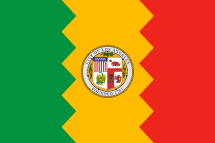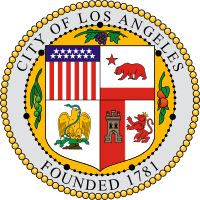Fletcher Bowron
| Fletcher Bowron | |
|---|---|
 | |
| Mayor Bowron (second from right) at Cinco de Mayo celebration, 1952 | |
| 35th Mayor of Los Angeles | |
| In office September 26, 1938 – July 1, 1953 | |
| Preceded by | Frank L. Shaw |
| Succeeded by | Norris Poulson |
| Personal details | |
| Born | August 13, 1887 Poway, California |
| Died | September 11, 1968 (aged 81) Los Angeles, California |
| Political party | Republican |
| Spouse(s) | Irene Martin, Albine Norton |
| Children | Barry Bowron |
| Residence | Los Angeles, California |
Fletcher Bowron (August 13, 1887 – September 11, 1968) was an American lawyer, judge and politician. He was the 35th mayor of Los Angeles, California, from September 26, 1938, until June 30, 1953. He was the longest-serving mayor to date in the city, presiding over the war boom and very heavy population growth, and building freeways to handle them.
Life and career
Bowron was born in Poway, California, the youngest of three children. His Yankee parents, who had migrated from the Midwest, sent him to Los Angeles High School, where he graduated in 1904. In 1907, he began studies at UC Berkeley, where his two brothers had graduated, then enrolled in the University of Southern California Law School two years later. He dropped out of law school and became a reporter for San Francisco, Oakland and Los Angeles newspapers, working the City Hall and court beats in the latter city. He was finally admitted to the bar in 1917.
Upon the U.S. entry into World War I in 1917, Bowron enlisted in the Army, serving in the 14th Field Artillery before transferring to the military intelligence division. Upon his return, he once again practiced law before he married Irene Martin in 1922. The following year, he was appointed as a deputy state corporations commissioner. His work in that capacity caught the attention of California governor, Friend Richardson, who hired him as executive secretary in 1925, and then appointed him to the superior court in 1926.
In his first tenure as a superior court judge, which lasted 12 years, Bowron became the first jurist on the West Coast to use the pre-trial calendar system.
Mayor
He was then elected mayor of Los Angeles on a fusion ticket in 1938 in the wake of the corruption arising from the previous administration of Frank L. Shaw, and earned the reputation of being lawful, unlike his predecessor. One example came when he replaced the city's chief of police with William H. Parker because of the rampant corruption within the Los Angeles Police Department. This was part of what he called the Los Angeles Urban Reform Revival.

Los Angeles grew enormously during the war years, with very large defense industries. After the war Bowron began construction of the Los Angeles International Airport and the 1st phases of the elaborate freeway system. He obtained hundred million dollars from the Federal Housing Authority for the construction of 10,000 units. As president of the American Municipal Association, representing 9500 cities, he was the leader of the nation's mayor in their dealings with the federal government. A high priority was eliminating organized crime from the city's police department.. He forced the resignation of numerous officers, and prevented Los Angeles from becoming a wide open town. Bowron ran on nonpartisan fusion tickets, but his popularity declined in his 4th term. The Los Angeles Citizens Committee demanded his recall, claiming he was responsible for high taxes and continued police corruption.. In 1952 he lost his reelection bid in the Republican primary to Norris Poulson, a conservative opponent of public housing.[2]
He served during the era of World War II, most notably supporting the removal of Japanese Americans from California and their subsequent detention in inland concentration camps. In January 1942 Bowron began to call for relocating Japanese Americans away from the coast and putting them to work in farm labor camps. He forced all Japanese American employees of the City of Los Angeles to take a leave of absence and circulated propaganda targeted at people of Japanese descent.[3] By February he was pushing for mass incarceration on his radio show, quoted on Abraham Lincoln's birthday in support of the camps: "There isn't a shadow of a doubt but that Lincoln, the mild-mannered man whose memory we regard with almost saint-like reverence, would make short work of rounding up the Japanese and putting them where they could do no harm."[4] He continued by calling them "the people born on American soil who have secret loyalty to the Japanese Emperor."[5] Knowing that the large number of citizen Nisei and Sansei (over two-thirds of the 120,000 "evacuees") would create a difficult legal situation, Bowron attempted to pass a constitutional amendment under which American-born Japanese would be stripped of their citizen rights if they held dual U.S.-Japanese citizenship or if their parents were ineligible for U.S. citizenship. He also proposed allowing the government to ignore portions of the Selective Service Act and call Japanese Americans, including women and those whose age or physical status would otherwise exempt them, into non-combat military service.[3]
Later life
He lost re-election in 1953 after having survived a number of recall attempts, with his defeat linked partly because his liberal backing began to wane as a result of McCarthyism. In 1956, he once again ran for superior court judge, defeating Joseph L. Call in the November election. Serving one six-year term, he retired from political office in 1962, but remained active in city activities.
He played himself on the January 29, 1953 episode of "The George Burns and Gracie Allen Show" the episode was titled "The Tax Refund.[6]"
On January 4, 1961, his wife Irene died at the Madison Lodge Sanitarium after spending nearly five years at the facility. Ten months later, Bowron married his long-time executive assistant, Albine Norton.
Following his retirement from the bench, he served as director of the Metropolitan Los Angeles History Project, hiring Robert C. Post, then a graduate student at UCLA, as his chief researcher. In 1967, Bowron was named chairman of the city's Citizen's Committee on Zoning Practices and Procedures.
After finishing work on September 11, 1968 he suffered a fatal heart attack while driving home. While his body lay in state in the Los Angeles City Hall rotunda, few people came to pay their respects.[7] He was buried at Inglewood Park Cemetery.
See also
- Employers Group, which, as the Merchants and Manufacturers Association, opposed Bowron's policies
- Stephen W. Cunningham, Republican City Council member who ran against Bowron in 1941
- Harold Harby, Los Angeles City Council member, 1939–42, 1943–57, complained about Bowron's radio talks
- John C. Holland, Los Angeles City Council member, 1943–67, Bowron supporter
Purge list
Bowron urged the defeat of these opposition City Council candidates in 1939:[8]
In popular culture
In the 2011 video game L.A. Noire, the mayor is based on Fletcher Bowron, and coincides with the name and personality.
References
- ↑ http://unitproj.library.ucla.edu/dlib/lat/display.cfm?ms=uclalat_1429_b14_45319&searchType=subject&subjectID=213941
- ↑ Eleonora W. Schoenebaum, ed. Political Profiles: The Truman Years (1978) pp 46-47
- ↑ 3.0 3.1 Nakagawa, Martha. "Fletcher Bowron". Densho Encyclopedia. Retrieved 16 October 2014.
- ↑ Page Smith (1995). Democracy on Trial: The Japanese American Evacuation and Relocation in World War 2. Simon & Schuster.
- ↑ Edward Norton Barnhart; Floyd W. Matson (1954). Prejudice, War, and the Constitution. University of California Press. p. 84.
- ↑ http://www.imdb.com/title/tt1696368/
- ↑ "Only a Few Honor Ex-Mayor Bowron at City Hall Rotunda," Los Angeles Times, 14 September 1968, page B1.
- ↑ "Council Slates Announced as Bowron Pushes Purge," Los Angeles Times, March 2, 1939, page 6
Library card required
Further reading
- Buntin, John (2009). L.A. Noir: The Struggle for the Soul of America's Most Seductive City. New York: Harmony Books. ISBN 9780307352071. OCLC 431334523. Retrieved 8 October 2014.
- Sitton, Tom. Los Angeles Transformed: Fletcher Bowron's Urban Reform Revival, 1938-1953. ISBN 0-8263-3527-6.
- Starr, Kevin. Golden Dreams: California in an Age of Abundance, 1950-1963. ISBN 0-19-515377-4.
| ||||||||||||||||
|

